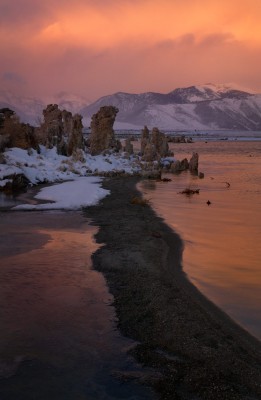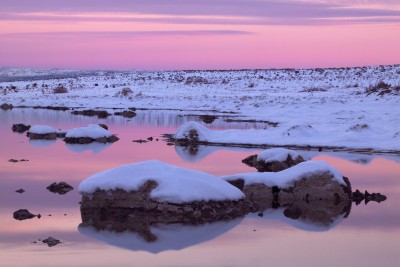Mono Lake is one of the most famous California nature photography sites, that fame is a consequence of both it’s photographic and environmental history. Environmentally it supports the second largest population of California gulls (the first, paradoxically, being in Utah), that support was threatened by the diversion of streams that provide water to the late for use by the Los Angeles Department of Water and Power, 300 miles away. Photographically, tufa, the strange limestone formations exposed by the lowering lake level, the backdrop of the Sierra Nevada to the west, and the gull population provide a rich source of photographic opportunities. In this post, I hope to excite you (just a little bit) about the area, and suggest a few places you might want to begin your photographic exploration of the area.
The most frequented area of the lake is the “South Tufa Area”, located along the south side of the lake. While often a busy and well-frequented area, the number, size and variety of the tufa formations there are unparalleled. Your biggest challenge many times of year will be other photographers, but the area is large and gets interesting light both at sunrise (both toward the Sun and toward the Sierra) and just past suns, when the geography and elevation often provide strong, saturated earth shadows such as the one in the image I’ve included above.
A second location is what’s referred to as the “Old Marina” area, accessed from highway 395 just north of the Mono Basin National Forest Scenic Area Visitor Center. This area does not contain the dramatic tall tufa of the South Tufa area, but the numerous formations in water provide interesting opportunities and challenges for sunrise silhouettes, and post-sunset earth shadows again are often very strong here. Because this area provides the most direct scenics looking directly east, it offers opportunities for shooting directly into the rising sun, or toward the rising moon.
A great area “off the beaten track” is found just east of Black Point along the north side of the lake. From highway 395, take Cemetery Road east past the cemetary, it becomes a dirt wide graded dirt road. After passing the tall hill that is black point, a thinner brach of the road heads back south towards the lakeshore and ends in a small parking area, from there it’s a simple 10-minute walk down to the lake shore near Negit and Paoha Islands. Again, smaller formations in water dominate here, and my best experiences in the area have been before, during and after sunset.
Most of these areas are available save for intermittent periods during the winter. While access can be limited in parts of winter, the combination of the strange formations and winter snow can be quite powerful. Fall is also popular, with good reason (there are a few lovely areas of aspen near the lake), but far more crowded for the photographically minded.
For bird photographers, gulls arrive in number in June, their chicks hatching in June on the islands inside the lake, and increase in numbers probably through August, only to by the end of September. While there’s a fair number of gulls along the shore, canoe tours after breeding season is over provide access to greater numbers of birds. Eared grebes are an August-early November opportunity. Avocets in breeding plumage are common in March and April.
Do stop by the Mono Lake Committee’s visitor center in Lee Vining as well, they can provide excellent information on current birding, flower and road conditions. They also offer photographic workshops (that attract beginners through pros), and they often have a photographic exhibit from the area as well.

